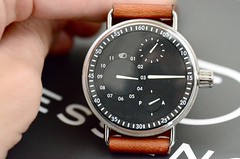
In today's world, the idea of having to wind your watch for it to keep the allowable time seems preposterous. However, the truth is that population had to wind their watches for hundreds of years. The automatic watch, or self-winding watch, was not invented until 1770. It was this innovation that defined modern watch-making and revolutionized the way population colse to the world keep track of time.
The automatic watch was invented in 1770 by Swiss watchmaker Abraham-Louis Perrelet. In that year, Perrelet advanced a self-winding mechanism for pocket watches using the same principles applied in modern pedometers. As the watch-wearer walked, the mechanism moved up and down, thus winding the watch automatically. Just a few years after this invention, the Geneva society of Arts reported that Perrelet invention allowed the watch to wind sufficiently for eight days of time-keeping with only 15 minutes of walking. And so the automatic watch was born.
Perrelet at last sold some of his watch designs to fellow watchmaker, Abraham-Louis Breguet. Breguet would make some changes to the design, but his new fabricate was finally unreliable and he discontinued the fabricate of his own design. The traction behind the conversion to automatic mechanisms indubitably began when the fabricate was applied to wristwatches. While pocket watches required the watch owner to indubitably walk colse to with the watch, wristwatches featuring an automatic mechanism would wind whenever a person moved his or her arm up and down. This meant that virtually all movements resulted in automatic winding. The first person to apply the automatic conception to the wristwatch was a man by the name of John Harwood. Harwood took out patents captivating mechanisms that became known as "hammers" or "bumpers." While this mechanism only wound the watch when it was moved in one direction, it did allow for 12 hours of autonomous watch functionality when it was fully wound. This watch was produced in a lot of 30000, and was the first commercially prosperous automatic watch.
automated Watches - A Brief HistoryRolex provided the final push towards the approximately universal adoption of the automatic watch. In 1930, the Rolex Watch firm improved John Harwood's mechanism fabricate in order to allow the watch to wind from movement in any direction. The firm also improved the capacity of the mainspring to store the energy created by this movement, enabling the watch to run autonomously for up to 35 hours. Rolex's adoption of this technology led many other clubs to fabricate their own automatic watches, and by the 1960s, automatic watches were being sold by countless manufacturers. The Omega automatic watch, the Tissot automatic watch, and the Invicta automatic watch are some sublime additions to the world of automatic winding watches.
Today, automatic watches have become ubiquitous, and manually winding watches have become merely curiosities for most people. However, there is truly a rich history behind the invention and improvement of this now ordinary technology.
watches for saleRelated : TAG Heuer Men's WAF1110.BA0800 CHEAP SONY HDTV SALE internet tv sale
No comments:
Post a Comment